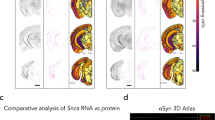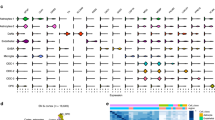Abstract
We have used RNA in situ hybridization to study the regional expression of the Huntington's disease gene (HD) and its rat homologue in brain and selected nonneural tissues. The HD transcript was expressed throughout the brain in both rat and human, especially in the neurons of the dentate gyrus and pyramidal neurons of the hippocampal formation, cerebellar granule cell layer, cerebellar Purkinje cells and pontine nuclei. Other brain areas expressed lower levels of the HD transcript without pronounced regional differences. Neuronal expression predominated over glial expression in all regions. HD mRNA was also expressed in colon, liver, pancreas and testes. The regional specificity of neuropathology in HD, which is most prominent in the basal ganglia, thus cannot be accounted for by the pattern of expression of HD.
This is a preview of subscription content, access via your institution
Access options
Subscribe to this journal
Receive 12 print issues and online access
$209.00 per year
only $17.42 per issue
Buy this article
- Purchase on Springer Link
- Instant access to full article PDF
Prices may be subject to local taxes which are calculated during checkout
Similar content being viewed by others
References
Folstein, S. In Huntington's Disease: A Disorder of Families (Johns Hopkins, Baltimore, 1989).
Quarrel, O. & Harper, P.S. In Huntington's Disease (ed. Harper, P.S.) 37–80 (W.B. Saunders, Philadelphia, 1991).
Morris, M. In Huntington's Disease (ed. Harper, P.S.) 81–126 (W.B. Saunders, Philadelphia, 1991).
Quarrel, O. In Huntington's Disease (ed. Harper, P.S.) 141–178 (W.B. Saunders, Philadelphia, 1991).
Beal, M.F. Does impairment of energy metabolism result in excitoxic neuronal death in neurodegenerative illnesses?. Ann. Neurol. 31, 119–130 (1992).
Huntington's Disease Collaborative Research Group. A novel gene contianing a trinucleotide repeat that is expanded and unstable on Huntington's disease chromosomes. Cell 72, 971–983 (1993).
DiFiglia, M. Excitotoxic injury of the neostriatum: a model for Huntington's disease. Trends Neurosci. 13, 286–289 (1990).
Wexler, N.S. et al. Homozygotes for Huntington's disease. Nature 326, 194–197 (1987).
Myers, R.H. et al. Homozygote for Huntington Disease. Am. J. hum. Genet. 45, 615–618 (1989).
Sabourin, L.A. et al. Effect of the myotonic dystrophy (DM) mutation on mRNA levels of the DM gene. Nature Genet. 4, 233–238 (1993).
Fu, Y.H. et al. Decreased expression of myotonin-protein kinase messenger RNA and protein in adult form of myotonic dystrophy. Science 260, 235–238 (1993).
Rosen, D.R. et al. Mutations in Cu/Zn superoxide dismutase gene are associated with familial amyotrophic lateral sclerosis. Nature 362, 59–62 (1993).
Ferrante, R.J. et al. Selective sparing of a class of striatal neurons in Huntington's disease. Science 230, 561–563 (1985).
Dawbarn, D., DeQuidt, M.E. & Emson, P.C. Survival of basal ganglia neuropeptide Y-somatostatin neurons in Huntington's disease. Brain Res. 340, 251–260 (1985).
Ferrante, R.J., Beal, M.F., Kowall, N.W., Richardson, E.P. & Martin, J.B. Sparing of acetylcholinesterase-containing striatal neurons in Huntington's disease. Brain Res. 411, 162–166 (1987).
Hirsch, E.C., Graybiel, A.M., Hersh, L.B., Duyckaerts, C. & Agid, Y. Striosomes and extrastriosomal matrix contain different amounts of immunoreactive choline acetyttransferase in the human striatum. Neurosci. Lett. 96, 145–150 (1989).
Herrington, K.M. & Kowall, N.W. Parvalbumin immunoreactive neurons resist degeneration in Huntington's disease striatum. J. Neruopath. Exp. Neurol. 50, 309 (1991).
Reiner, A. et al. Differential loss of striatal projection neurons in Huntington disease. Proc. natn. Acad. Sci. U.S.A. 85, 5733–5737 (1988).
Albin, R.L. et al. Abnormalities of striatal projection neurons and N-methyl-D-aspartate receptors in presymptomatic Huntington's disease. New Engl. J. Med. 322, 1293–1298 (1990).
Sambrook, J., Fritsch, E.F. & Maniatis, T. In Molecular Cloning: A Laboratory Manual (Cold Spring Harbor Laboratory Press, New York, 1989).
Devereux, J., Haeberli, P. & Smithies, O. A comprehensive set of sequence analysis programs for the VAX. Nucl. Acids Res. 12, 387–395 (1984).
Strong, T.V., Boehm, K. & Collins, F.S. Localization of cystic fibrosis transmembrane conductance regulator mRNA in the human gastro-intestinal tract by insitu hybridization. J. clin. Invest. (in the press).
Paxinos, G. & Watson, C. In The Rat Brain in Stereotaxic Coordinates (Academic Press, Orlando, 1986).
Author information
Authors and Affiliations
Rights and permissions
About this article
Cite this article
Strong, T., Tagle, D., Valdes, J. et al. Widespread expression of the human and rat Huntington's disease gene in brain and nonneural tissues. Nat Genet 5, 259–265 (1993). https://doi.org/10.1038/ng1193-259
Received:
Accepted:
Issue Date:
DOI: https://doi.org/10.1038/ng1193-259
This article is cited by
-
Naïve Huntington’s disease microglia mount a normal response to inflammatory stimuli but display a partially impaired development of innate immune tolerance that can be counteracted by ganglioside GM1
Journal of Neuroinflammation (2023)
-
Mutant huntingtin confers cell-autonomous phenotypes on Huntington’s disease iPSC-derived microglia
Scientific Reports (2023)
-
The evolutionary history of the polyQ tract in huntingtin sheds light on its functional pro-neural activities
Cell Death & Differentiation (2022)
-
RNA-seq analysis reveals significant transcriptome changes in huntingtin-null human neuroblastoma cells
BMC Medical Genomics (2021)
-
Label-free photothermal disruption of cytotoxic aggregates rescues pathology in a C. elegans model of Huntington’s disease
Scientific Reports (2021)



